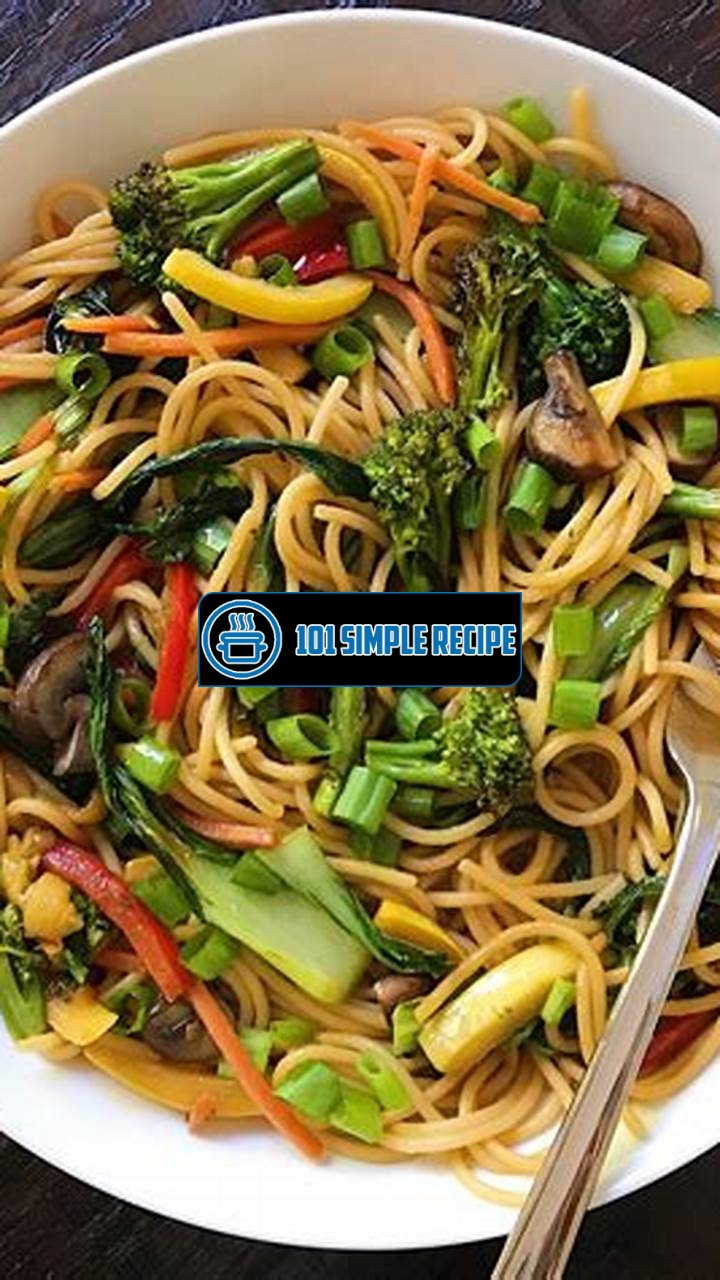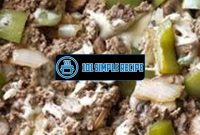Are you a vegan looking for a mouthwatering dish to satisfy your cravings? Look no further than our delicious Vegan Lo Mein Noodles! This flavorful dish is packed with a medley of fresh vegetables, tender noodles, and a savory sauce that will leave your taste buds begging for more. Whether you’re a seasoned vegan or simply looking to explore plant-based options, this dish is sure to impress. With its vibrant colors, enticing aroma, and irresistible taste, our Vegan Lo Mein Noodles are guaranteed to become your new favorite go-to recipe. So grab your wok and get ready to embark on a culinary adventure!

The Origins of Vegan Lo Mein Noodles
Discover the history and cultural significance of vegan lo mein noodles and how they have evolved over time.
The Birth of Lo Mein Noodles
Lo Mein noodles have a long and fascinating history that dates back centuries. Originating in China, these noodles are a staple in Chinese cuisine and have gained popularity around the world. The term “lo mein” translates to “stirred noodles,” which accurately describes the cooking process.
The exact origins of lo mein noodles are debated, but it is believed that they were first created during the Han Dynasty (206 BC – 220 AD). Noodles, in general, have been a significant part of Chinese cuisine for over 4,000 years. However, the birth of lo mein noodles involved a unique cooking technique that sets them apart.
In the early days, lo mein noodles were made by mixing wheat flour with water and kneading the dough. The dough was then rolled out and cut into thin strips. These strips were cooked by stir-frying in a wok or pan, along with various ingredients and sauces. The result was a delicious and satisfying dish that quickly became popular.
Traditional Ingredients Used in Lo Mein Noodles
Over time, different regions in China developed their own variations of lo mein noodles, each with its own distinct flavors and ingredients. However, some traditional ingredients remain common across all versions of this dish.
The main components of traditional lo mein noodles include:
- Noodles: Thick, egg-based wheat noodles are commonly used in traditional lo mein recipes. The thickness and chewiness of these noodles make them ideal for absorbing the rich flavors of the sauce.
- Protein: Common protein choices for lo mein noodles include chicken, beef, shrimp, and pork. These proteins are marinated and stir-fried to perfection before being mixed with the noodles.
- Vegetables: Lo mein noodles feature an array of colorful vegetables, such as carrots, bell peppers, broccoli, and bean sprouts. These vegetables add freshness, texture, and a vibrant visual appeal to the dish.
- Sauce: A savory sauce made from soy sauce, oyster sauce, and various seasonings ties all the ingredients together. The sauce coats the noodles and infuses them with a rich umami flavor.
Each ingredient is carefully selected and prepared to create a balance of flavors and textures in traditional lo mein noodles.
Adapting Lo Mein Noodles to Veganism
In recent years, the popularity of veganism has led to the adaptation of traditional lo mein noodles to suit plant-based diets. The rise in demand for vegan options has prompted chefs and home cooks to explore creative alternatives to the traditional meat and egg-based ingredients.
Vegan lo mein noodles now feature a variety of plant-based protein options, such as tofu, tempeh, and seitan. These protein sources are marinated or seasoned to mimic the flavors and textures of traditional meats, providing a satisfying and delicious experience.
Additionally, a wide range of vegetables are used in vegan lo mein noodles, including mushrooms, zucchini, spinach, and snow peas. These vegetables add both nutritional value and vibrant colors to the dish, making it visually appealing.
When it comes to the sauce, vegan versions often use soy sauce, tamari, or vegan oyster sauce as a base, combined with other seasonings to create a flavorful and umami-rich dressing for the noodles.
The adaptation of lo mein noodles to veganism not only caters to those following a plant-based lifestyle but also brings new and exciting flavors to the dish. Vegan lo mein noodles offer a delicious and satisfying alternative that can be enjoyed by everyone, regardless of their dietary preferences.
Health Benefits of Vegan Lo Mein Noodles
When it comes to satisfying your cravings for a delicious meal, vegan lo mein noodles are a fantastic option. Not only are they packed with flavor and texture, but they also offer numerous health benefits that can contribute to a balanced diet. Let’s explore the nutritional advantages of choosing vegan lo mein noodles as part of your daily meals.
Low in Calories and Fat
If you’re conscious about your calorie and fat intake, vegan lo mein noodles are an excellent choice. Unlike traditional lo mein noodles that are made with egg, vegan versions are typically lower in calories and fat. This makes them a great option for those who are watching their weight or looking to maintain a healthy lifestyle.
By opting for vegan lo mein noodles, you can still enjoy a satisfying and filling meal without worrying about excessive calorie or fat intake. This is especially beneficial if you’re looking to shed a few pounds or maintain a healthy weight.
Packed with Essential Nutrients
Vegan lo mein noodles are not only low in calories and fat but are also packed with essential nutrients that your body needs. These noodles are typically made from whole wheat flour, which provides a good amount of dietary fiber, B vitamins, and minerals like iron and zinc. Including these nutrients in your diet can help support various bodily functions and promote overall well-being. ✨
When you consume vegan lo mein noodles, you’re fueling your body with the necessary nutrients it needs to thrive. This can contribute to improved energy levels, enhanced digestion, and better overall health. Additionally, these noodles are also a great source of antioxidants, which can help protect your body against oxidative stress and damage caused by free radicals.
High in Fiber and Plant-Based Protein
One of the standout features of vegan lo mein noodles is their high fiber and plant-based protein content. Fiber is essential for maintaining a healthy digestive system and can help prevent constipation and promote bowel regularity. Plant-based protein, on the other hand, is a valuable nutrient for vegans and vegetarians who may need to find alternative protein sources.
By incorporating vegan lo mein noodles into your diet, you can enjoy a meal that not only tastes great but also provides you with a good amount of fiber and protein. This can help keep you feeling fuller for longer, support muscle growth and repair, and contribute to a balanced and nutritious meal.
Overall, the health benefits of vegan lo mein noodles are numerous. From being low in calories and fat to being packed with essential nutrients, fiber, and plant-based protein, these noodles offer a tasty and nutritious addition to any diet. So why not satisfy your cravings with a scrumptious bowl of vegan lo mein noodles and reap the benefits for your overall health and well-being?
The Art of Preparing Vegan Lo Mein Noodles
Are you ready to embark on a culinary adventure that combines mouthwatering flavors and plant-based goodness? Look no further than the world of vegan lo mein noodles. In this article, we will delve into the art of preparing this delectable dish, sharing techniques and tips that will turn your kitchen into a gourmet haven.
Selecting the Perfect Noodles
Prioritize the Right Noodle Texture: The backbone of any good vegan lo mein dish lies in the choice of noodles. Achieving that authentic chewy texture is key. Opt for wheat-based noodles like Hokkien or udon, as they can withstand the intense heat of stir-frying while maintaining their characteristic bite.
Pay Attention to Cooking Times: Take note of the suggested cooking times on the packaging of your chosen noodles. Overcooked noodles can become mushy and ruin the overall dish. Aim to cook them until al dente, ensuring they retain their firmness and texture.
Rinse the Noodles Under Cold Water: After cooking the noodles, rinse them under cold water to remove excess starch and prevent sticking. This step also helps to cool them down, making them easier to handle during the stir-frying process.
Creating Flavorful Sauces
Experiment with Soy Sauce Varieties: Soy sauce is an essential ingredient in vegan lo mein sauces, imparting a rich umami flavor. Try using different types of soy sauce, such as light soy sauce for a milder taste or dark soy sauce for a more robust and caramelized flavor profile.
Enhance with Aromatics: Elevate your sauce by adding aromatic ingredients like minced garlic, grated ginger, or finely chopped scallions. These ingredients provide depth and complexity to the overall flavor profile of your lo mein dish.
Sweeten the Sauce: To balance the savory flavors, add a touch of sweetness to your sauce. Options like agave syrup or maple syrup work well, giving the sauce a delightful hint of sweetness without overpowering the other flavors.
Incorporating Vibrant Vegetables and Toppings
Embrace a Rainbow of Colors: Make your vegan lo mein visually appealing by incorporating a variety of vibrant vegetables. Bell peppers, carrots, broccoli, and snow peas not only add color but also provide a range of textures and flavors.
Take Tofu to the Next Level: Tofu is a fantastic addition to vegan lo mein, offering a protein-packed alternative to meat. For a delicious twist, marinate the tofu in soy sauce and spices before stir-frying. This will infuse the tofu with flavor and give it a delightful chewy texture.
Finish with a Sprinkle of Exquisite Toppings: To add a final touch of finesse to your dish, consider garnishing with freshly chopped cilantro or toasted sesame seeds. These toppings not only provide a burst of flavor but also enhance the presentation of your vegan lo mein noodles.
There you have it, a comprehensive guide to preparing and savoring the irresistible wonders of vegan lo mein noodles. The art lies in selecting the perfect noodles, creating flavorful sauces, and incorporating vibrant vegetables and toppings. So, tie on your apron, sharpen your chopsticks, and let your creativity run wild as you whip up a delightful vegan lo mein masterpiece in your very own kitchen!
Exploring Variations of Vegan Lo Mein Noodles
When it comes to satisfying your cravings for a delicious vegan meal, there’s nothing quite like a hearty bowl of lo mein noodles. These Chinese-inspired dishes are known for their savory flavors and satisfying textures, making them a popular choice among vegans and non-vegans alike. In this article, we’ll take a closer look at some exciting twists and unique flavors that can be incorporated into vegan lo mein noodle dishes, so get ready to tantalize your taste buds!
Spicy Szechuan Lo Mein Noodles
If you’re a fan of spicy food, then this variation of vegan lo mein noodles is sure to be right up your alley. The Szechuan style is known for its bold and fiery flavors, making it a perfect choice for those who crave a little extra heat. To achieve this mouth-watering dish, you’ll need ingredients such as Szechuan peppercorns, chili oil, soy sauce, and an array of fresh vegetables. The combination of the spicy kick and the umami-rich soy sauce creates a flavor explosion that will leave you wanting more.
Garlic and Ginger-infused Lo Mein Noodles
For those who enjoy the aromatic flavors of garlic and ginger, this variation of vegan lo mein noodles is a must-try. The combination of these two ingredients adds depth and complexity to the dish, giving it a deliciously fragrant and savory taste. Start by sautéing minced garlic and ginger in a wok or skillet until fragrant before adding cooked noodles and a medley of colorful vegetables. The result is a mouth-watering dish bursting with flavors that will leave your taste buds begging for more.
Sweet and Sour Lo Mein Noodles with Pineapple
Looking for a vegan lo mein noodle dish that offers a perfect balance of sweet and tangy flavors? Look no further than the sweet and sour variation with pineapple. This delightful combination of ingredients will transport your taste buds to a tropical paradise. By incorporating pineapple chunks, bell peppers, and a tangy sweet and sour sauce made from rice vinegar, sugar, and soy sauce, you’ll create a dish that is not only visually appealing but also bursting with contrasting flavors.
No matter which variation of vegan lo mein noodles you choose to explore, rest assured that your taste buds will be in for a treat. These dishes offer a delightful combination of flavors, textures, and aromas that are sure to satisfy even the most discerning palate. So why not give them a try and embark on a culinary adventure that will leave you craving for more vegan lo mein noodles? Bon appétit!
Tips for Ordering Vegan Lo Mein Noodles from Restaurants
Navigate menus and communicate effectively to ensure you receive a satisfying vegan lo mein noodle dish while dining out.
Informing the Server about Dietary Restrictions
When dining out and looking to order vegan lo mein noodles, it’s crucial to inform your server about your specific dietary restrictions. Clearly communicate that you follow a vegan diet, which means you avoid all animal products, including meat, dairy, and eggs. Informing the server right from the start will help them guide you towards suitable options on the menu.
Remember to clearly state your dietary restrictions to ensure that the restaurant understands your needs.
Requesting Substitutions and Modifications
To ensure your vegan lo mein noodles align with your preferences and dietary needs, don’t hesitate to request substitutions and modifications. For example, you can ask for tofu instead of meat or request additional vegetables. Most restaurants are accommodating and will make the necessary adjustments to meet your requirements. However, it’s important to be polite and understanding while making these requests.
Feel free to ask for personalized modifications to make your vegan lo mein noodles even more enjoyable.
Understanding Hidden Ingredients
Although lo mein noodles might seem vegan-friendly on the surface, it’s essential to be aware of hidden ingredients that could compromise the dish’s vegan status. Some restaurants may use oyster sauce, fish sauce, or other non-vegan ingredients in their sauces or dressings. Therefore, it’s crucial to ask about the sauce’s ingredients and ensure they don’t contain any animal-derived products.
Be diligent inquiring about the ingredients used in the sauce to avoid any unintentional consumption of non-vegan ingredients.
By following these tips, you can experience delicious vegan lo mein noodles at restaurants without any worries or compromises. Remember to navigate menus effectively, communicate your dietary restrictions clearly, request suitable substitutions, and be cautious about hidden non-vegan ingredients. Enjoy your flavorful vegan meal while dining out!
Frequently Asked Questions
Thank you for taking the time to read our article on vegan lo mein noodles. We hope you found the information useful and inspiring for your next plant-based meal. If you have any further questions, please take a look at the FAQs below. We are here to assist you on your vegan culinary journey.
| No. | Questions | Answers |
|---|---|---|
| 1. | Is lo mein vegan? | Yes, lo mein can be made vegan by using plant-based ingredients such as tofu or tempeh, and substituting soy sauce for any non-vegan sauces. |
| 2. | What vegetables can I add to vegan lo mein noodles? | You can add a variety of vegetables to vegan lo mein noodles, such as broccoli, carrots, bell peppers, mushrooms, and snap peas, to name a few. Feel free to get creative and use your favorite veggies! |
| 3. | Can I use gluten-free noodles for vegan lo mein? | Absolutely! There are many gluten-free noodle options available, such as rice noodles or soba noodles, that work well for vegan lo mein. |
| 4. | How do I make vegan lo mein sauce? | To make a flavorful vegan lo mein sauce, combine soy sauce, sesame oil, rice vinegar, maple syrup or agave, minced garlic, grated ginger, and a pinch of red pepper flakes. Adjust the ingredients to suit your taste preferences. |
| 5. | Can I add protein to vegan lo mein noodles? | Yes, you can add protein to vegan lo mein noodles by including ingredients like tofu, tempeh, seitan, or edamame. These options provide a delicious and nutritious boost to your meal. |
| 6. | Is vegan lo mein a healthy meal choice? | Vegan lo mein can be a healthy meal choice, especially when packed with a variety of colorful vegetables and using whole grain noodles. It’s a great way to incorporate plant-based ingredients and fiber into your diet. |
Thank you for reading and visit again!
We appreciate you taking the time to explore the world of vegan lo mein noodles with us. We hope this article has inspired you to try making this delicious and satisfying dish at home. Remember, the possibilities for customization are endless, so don’t be afraid to experiment and add your own personal touch. If you have any further questions or would like to share your experience with us, please feel free to reach out. Thank you for being a part of our culinary journey, and we hope to see you again soon!
Jump to Recipe
Vegan Lo Mein Noodles

A delicious vegan version of the classic lo mein noodles, packed with colorful vegetables and plant-based protein.
- 8 oz lo mein noodles
- 2 tbsp soy sauce
- 1 tbsp sesame oil
- 1 tbsp rice vinegar
- 1 tbsp maple syrup
- 2 cloves garlic (minced)
- 1 inch ginger (grated)
- Pinch of red pepper flakes
- 2 cups mixed vegetables (broccoli, carrots, bell peppers, mushrooms, snap peas)
- 8 oz tofu (cubed)
- 2 green onions (sliced)
- Bring a pot of water to a boil and cook the lo mein noodles according to package instructions. Drain and set aside.
- In a small bowl, whisk together the soy sauce, sesame oil, rice vinegar, maple syrup, minced garlic, grated ginger, and red pepper flakes. Set aside.
- Heat a large pan or wok over medium heat. Add a tablespoon of oil and stir-fry the mixed vegetables and tofu for 5-6 minutes, until the vegetables are tender and the tofu is golden.
- Add the cooked noodles to the pan and pour the sauce over them. Toss everything together until well coated and heated through.
- Garnish the vegan lo mein noodles with sliced green onions and serve hot. Enjoy!






